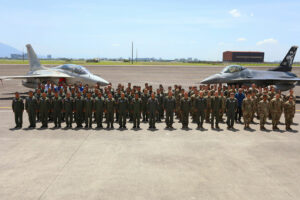THE PHILIPPINES and the US last week affirmed their commitment to boosting deterrence measures in the South China Sea amid China’s increasing assertiveness in the contested waterway.
In a statement on Monday, Philippine National Security Adviser Eduardo M. Año said he had met with US Secretary of State Marco Antonio Rubio in Washington, DC, where both sides discussed efforts to deepen their alliance and expand cooperation in defense and security.
“They underscored the need to enhance deterrence in the South China Sea and West Philippine Sea and the importance of maintaining peace and security in the region for the economic security of both the Philippines and the United States,” he said.
The meeting came as both countries aim to counter increasingly aggressive Chinese activities in the region, including the deployment of China Coast Guard and maritime militia vessels near Philippine-occupied features.
The 1951 Mutual Defense Treaty obligates both nations to come to each other’s aid in case of an armed attack in the Pacific area, including the South China Sea.
Relations between the two countries have strengthened under President Ferdinand R. Marcos, Jr., who has taken a more assertive stance against Beijing’s maritime claims.
The Marcos administration has expanded joint military exercises with US forces, opened additional sites under their Enhanced Defense Cooperation Agreement (EDCA) and pursued stronger ties with other Indo-Pacific partners.
China claims nearly the entire South China Sea through its so-called nine-dash line, a sweeping assertion that overlaps with the exclusive economic zones of Southeast Asian nations such as the Philippines, Vietnam, Malaysia and Brunei.
In 2016, a United Nations-backed arbitral tribunal in The Hague voided China’s expansive claims, ruling in favor of the Philippines. China, however, has rejected the ruling and continues to maintain a large presence in disputed areas, including Scarborough Shoal and the Spratly Islands.
Mr. Año said his discussion with Mr. Rubio included future activities aimed at enhancing defense cooperation and building a “credible deterrence posture” in the region.
“They also underscored the importance of engaging with traditional allies and other like-minded partners to ensure a rules-based international order and a free, open, and prosperous Indo-Pacific,” he said.
The visit came amid growing regional concern over China’s militarization and use of force in the South China Sea, including recent water cannon incidents targeting Philippine resupply missions to Second Thomas Shoal.
The Philippines has increasingly leaned on multinational cooperation to shore up its maritime defenses. It has participated in more frequent joint patrols and multilateral naval exercises in the South China Sea, often alongside US forces and other regional partners.
Multinational military cooperation, once rare in the contested waters, is fast becoming routine. Earlier this year, the Philippines conducted trilateral air and sea patrols with the US and Australia.
Washington has repeatedly assured Manila of its “ironclad” defense commitments under the Mutual Defense Treaty.
Beijing, for its part, has accused the US of stoking tensions and interfering in regional matters. It maintains that its activities in the South China Sea are lawful and aimed at safeguarding its sovereignty.
Despite diplomatic overtures, tensions continue to rise. Philippine officials have reported nearly daily sightings of Chinese maritime militia vessels within its EEZ. Confrontations at sea — including ramming incidents and the use of lasers and water cannons by Chinese forces — have led to repeated diplomatic protests from Manila. — Kenneth Christiane L. Basilio






